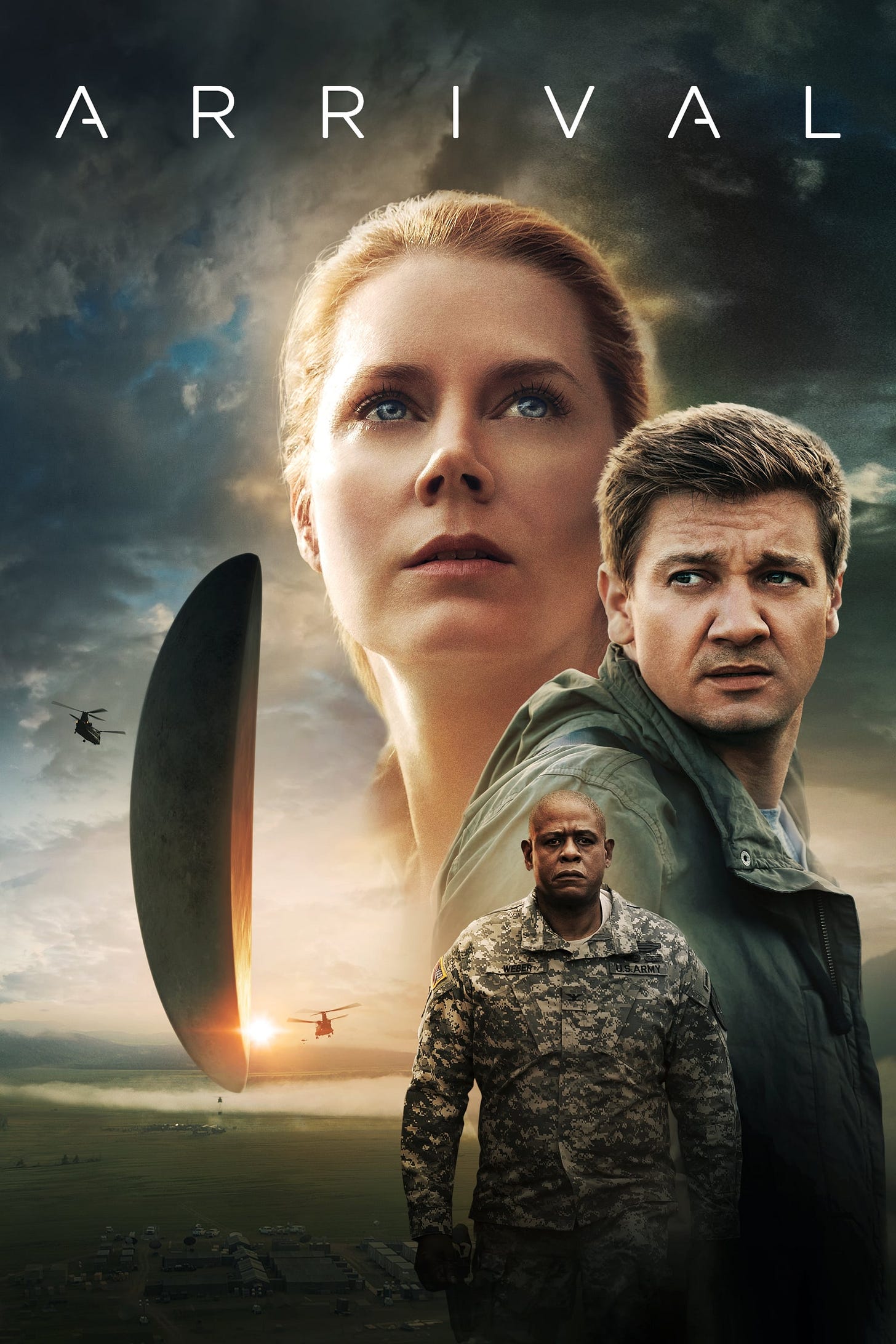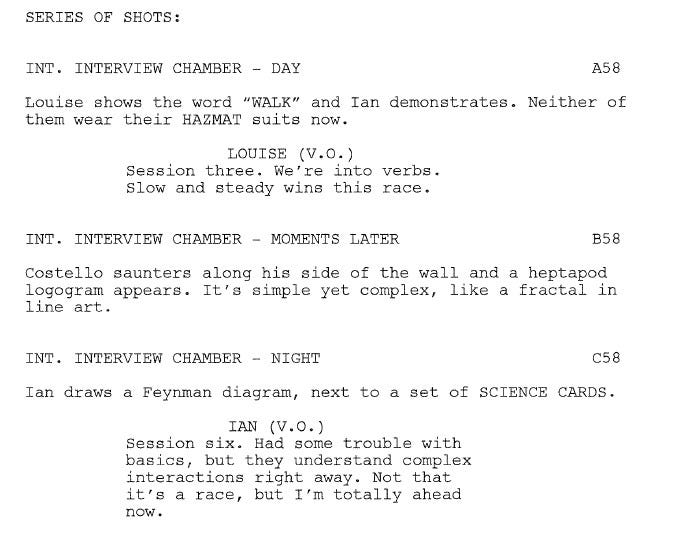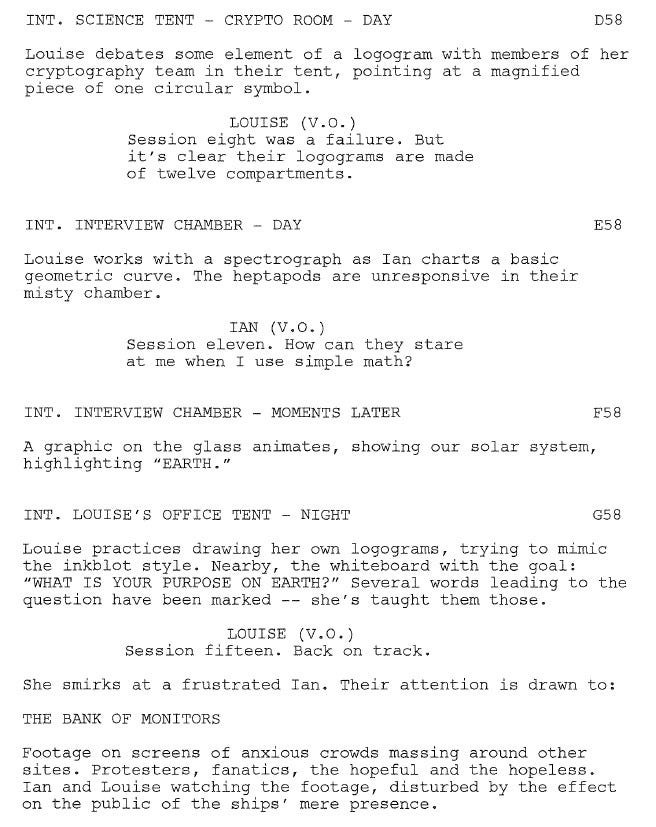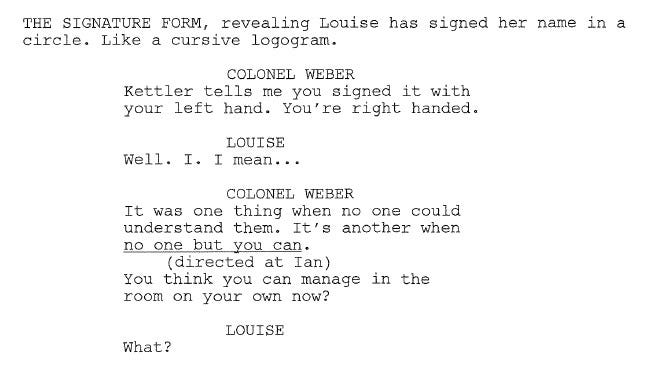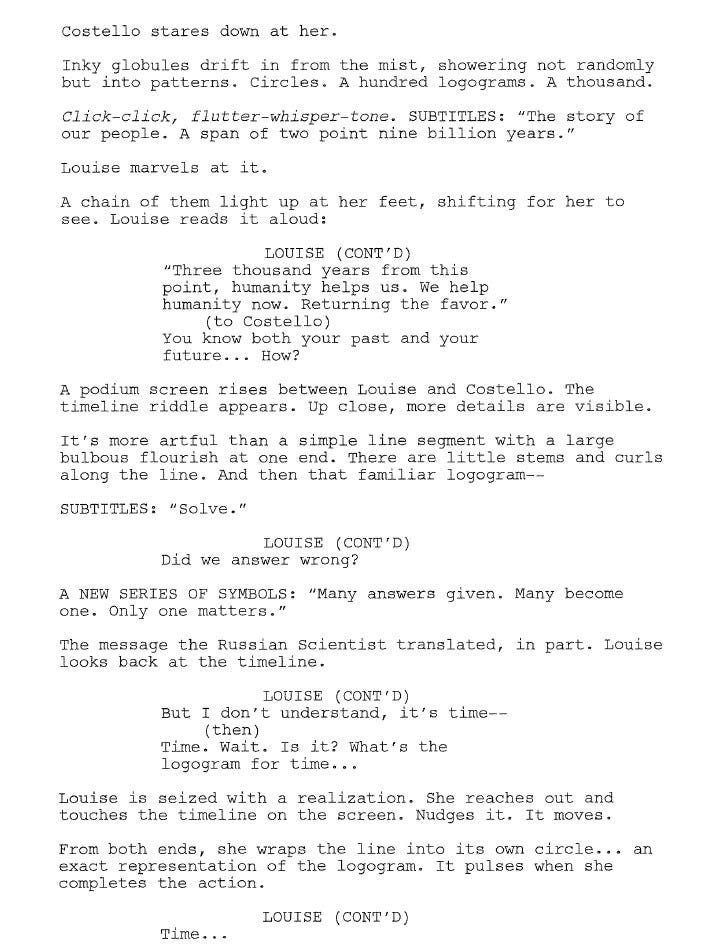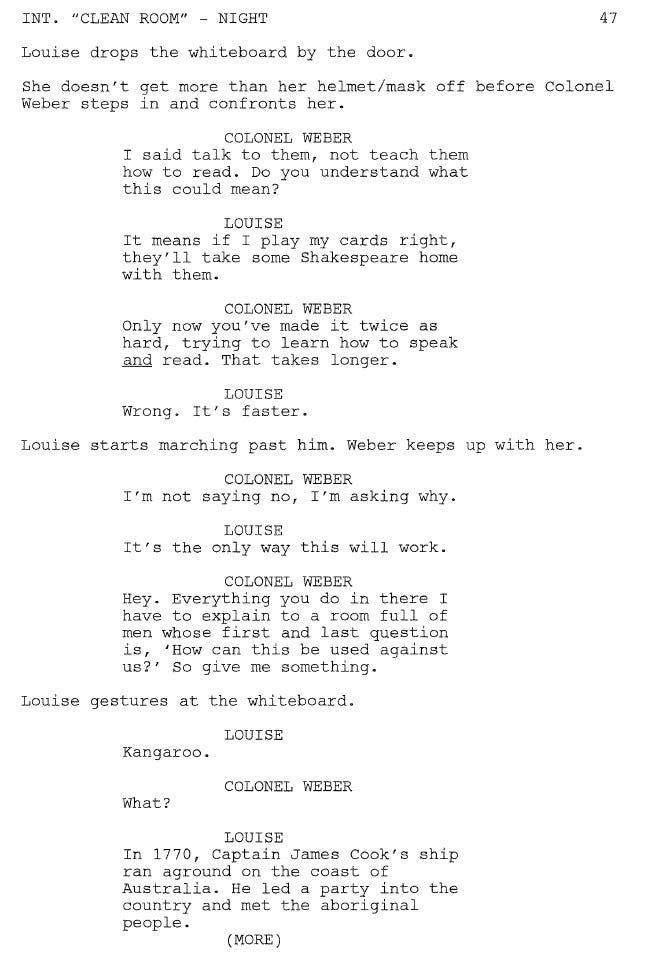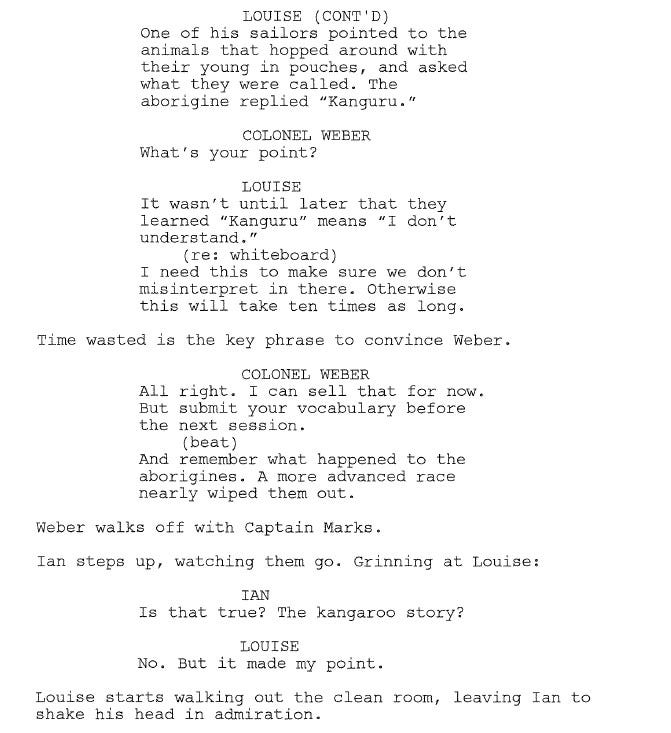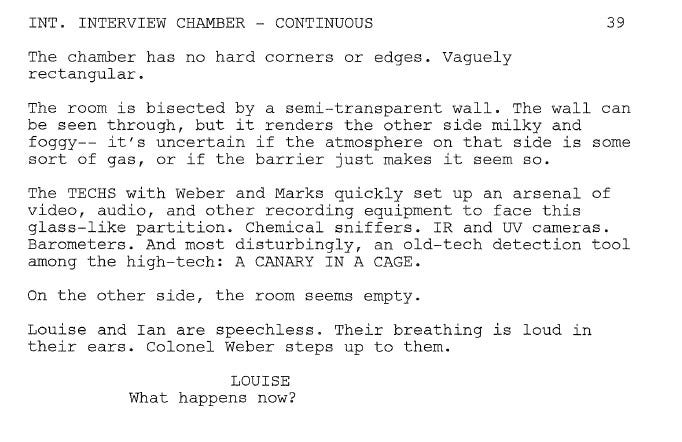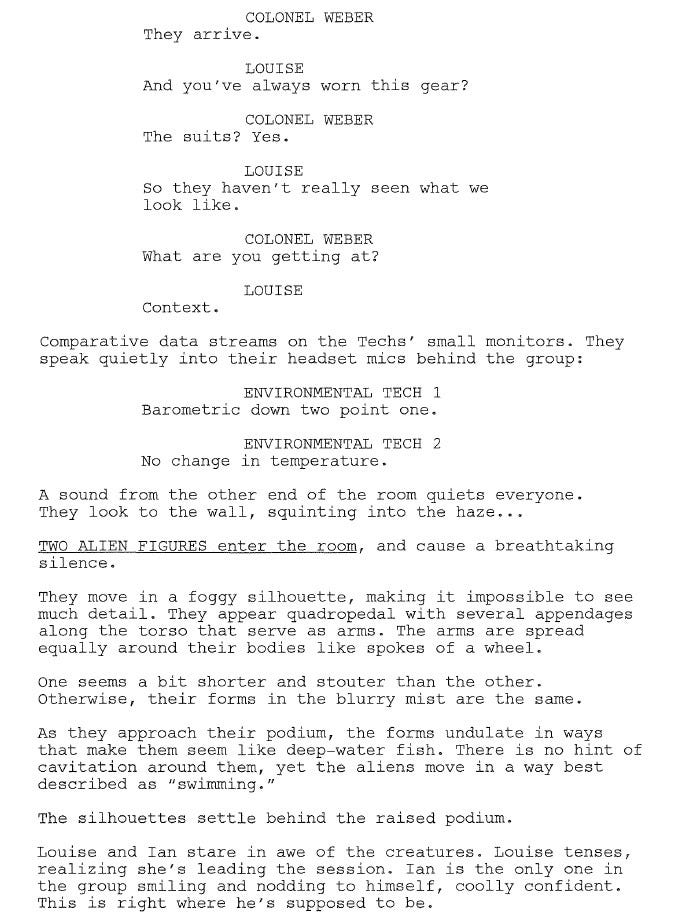Arrival (2016) Script Review | #27 WGA 101 Greatest Scripts of the 21st Century
A sci-fi story that subverts the alien invasion trope to tell a clever and emotionally devastating story.
Logline: When gigantic alien spaceships touch down in 12 locations around the world, linguistics professor Louise Banks is recruited by the military to lead an elite team of investigators to communicate with the aliens in order to determine whether they come in peace or are a threat.
Written by: Eric Heisserer
Based on: The short story “Story of Your Life” written by Ted Chiang
Pages: 118
Scenes: 125
Arrival asks, “What if aliens visited Earth to give humanity a valuable gift?” and turns the premise into a meditative story about how the perception of time can affect the way we look at life and make choices. Gut-wrenching in its final revelation, patient in its unfolding of the material, here is a screenplay that is unafraid to get intelligent.
Based on Ted Chiang’s immortal short story, ‘The Story of You,’ Arrival follows linguist Louise Banks, hired by Colonel Weber to decipher the unintelligible exchanges between the humans and a host of aliens who have landed all around the world. Unlike most alien stories, the extra-terrestrials—known as heptapods— do not speak English; if anything, Louise has to teach them English in order to communicate with them. That’s right, a bulk of the script is essentially an English as a Second Language class! Louise teams up with theoretical physicist, Ian Donnelly, and together, they must find a way to understand why the aliens have visited.
So far, so good. But along the way, something funny happens. Remember that final revelation I mentioned earlier? When the story begins, we see Louise raising—and losing—her young daughter, Hannah, to a terminal illness at a very young age. That introduction makes us see Louise as a mother who lost her child; although strangely, she never brings up the subject. The more she becomes immersed in the heptapod language, the more intense her flashbacks to Hannah grow. Only towards the end does the script pull the rug from under us, in a twist worthy of M. Night Shymalan: the flashbacks aren’t flashbacks— they’re flash-forwards! Louise is seeing the future, one in which she and Ian have a child named Hannah, who will die young.
What?
On page 72, Scene 80, Louise brings up a popular cognitive psychology theory known as the Sapir-Whorf hypothesis. The theory goes that our views and perspective are shaped by the language we speak; for instance, English speakers see and think differently from Chinese speakers purely on merit of language. What happens is that the heptapod language is free from the linear restrictions of time. This allows the heptapods to see past, present, and future as one; it also allows them to actually use future events to affect the past.
As Louise becomes increasingly fluent in the language, she too begins to see time differently. The implication is that Louise knows that conceiving Hannah will lead to her daughter’s untimely death; yet, she chooses to have the baby nevertheless.
The main plot—the A-plot—is a race against time to decipher the message brought by the heptapods before the paranoid countries launch a strike that could lead to war. Matters aren’t helped when the heptapods imply that they have traveled to Earth to offer a ‘weapon.’ Things take a worse turn when two xenophobic army privates set off explosives inside the space ship, killing one of the heptapods. The ‘weapon’, incidentally, is the heptapod language; they give it so that humanity will save their world, for in 3000 years, the heptapods will need humanity to save their world.
If the A-plot sounds something closer to a Hollywood product, your impression would not be wrong. Chiang’s short story is not action-packed; a feature film, especially one that will require a certain budget for the visual effects, needs something to keep the plot moving. As far as A-plots go, the one in Arrival gels well with Chiang’s story.
Eric Heisserer, the script’s credited writer, is an unlikely scribe for this material. Although he was mostly known in Hollywood circles for his work in horror, Heisserer was passionate about science-fiction. Around the time he optioned the rights to ‘The Story of You,’ he’d already written at least six science-fiction spec scripts. For Arrival, he wrote it on spec to get Chiang’s approval before securing the rights. It would take years to get the project greenlit and underway, during which time he wrote nearly 100 drafts of the story by his own estimate. A notable change included replacing a series of beats where Louise teaches basic vocabulary with an impassioned explanation of the process—that explanation arose from a note the producers raised in concern to the importance of those beats.
More changes would come after Denis Villeneuve boarded the project as director, including changing the title to Arrival; partly because The Story of You sounded like a rom-com, mostly because the adaptation, despite its roots in the source material, had morphed into its own thing.
To keep track between scenes set in the present and future, Heisserer used note cards with color-coded beats when he wrote. He also collected bits of information and dialogue to toss into the pot, and spent time with linguists and scientists to get the small details right. His past work in horror proved useful in his ability to build tension, such as the scene when Louise meets the heptapods for the first time.
He also has a writing style that immediately grabs your attention; he alternates between very short lines pressed together and action lines in the usual format, though in some places, he’ll insert plenty of description as needed. And sometimes, the writing will have some lovely moments.
Some scenes in the screenplay were left on the cutting room floor. These include the scenes were Ian uses a laser pointer and hand-sanitizer to demonstrate Fermat’s principle of least time. Considering that there’s 125 scenes in a script of 118 pages, it doesn’t surprise me that some parts had to be left behind.
I also like that Colonel Weber is not depicted as a stereotypical obtuse or power-hungry military man, but as a man trying to do what is best for everyone in a volatile situation. I like that the screenplay is a cerebral exercise disguised as a sci-fi thriller (it was nominated for the Academy Award for Best Adapted Screenplay1, and won the WGA Award in the same category, as well as the Hugo Award for Best Dramatic Presentation). Here is a thoughtful story about language and how it can shape us altogether. Heisserer’s belief in the story’s potential and his willingness to wait many years to get it made should inspire us: For if you believe in a story long enough, sooner or later, someone will be willing to make it.
Notes:
Grobar, Matt (November 30, 2016) | ‘Arrival’ Scribe Eric Heisserer Digs Into Process Of Adapting Ted Chiang’s Short Story, ‘Story Of Your Life’ (Deadline)
Tartaglione, Nancy (September 1, 2016) | Denis Villeneuve Talks ‘Arrival’, “A Vacation From Darkness” & The “Berserk” Risk Of ‘Blade Runner’ Sequel – Venice Q&A (Deadline)
Nguyen, Kevin (November 11, 2016) | How an Unfilmable Story Turned Into the Year’s Best Sci-Fi Movie (GQ)
Heisserer, Eric (November 10, 2016) | How I Wrote Arrival (and What I Learned Doing It) (Talkhouse)
St. James, Emily (November 15, 2016) | Arrival’s screenwriter tells us how it took more than 100 drafts to think like an alien (Vox)
Other contenders that year for Best Adapted Screenplay as well as Best Original Screenplay which made the cut for the WGA List of 101 Greatest Screenplays of the 21st Century include: Manchester by the Sea, La La Land, Hell or High Water, The Lobster (Adapted Screenplay); Moonlight (Original Screenplay).

